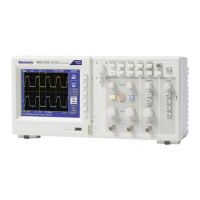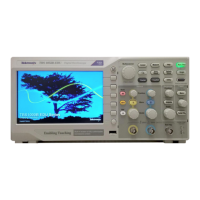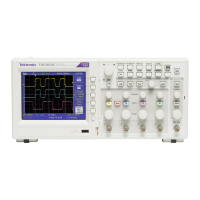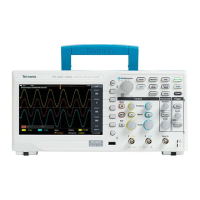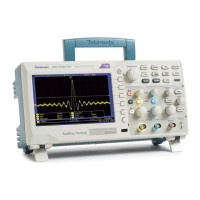FFT
FFT converts a time-domain (YT) signal into its frequency components
(spectrum). The oscilloscope can optionally display the source waveform at the
same time as the FFT waveform. Use FFT for the following types of analysis:
■
Analyze harmonics in power lines
■
Measure harmonic content and distortion in systems
■
Characterize noise in DC power supplies
■
Test impulse response of filters and systems
■
Analyze vibration
To use FFT, you need to perform the following tasks:
■
Set up the source (time-domain) waveform
■
Display the FFT spectrum
■
Select a type of FFT window
■
Adjust the sample rate to display the fundamental frequency and harmonics
without aliasing
■
Use cursors to measure the spectrum
Setting up the Time-Domain waveform
Before you use FFT, you need to set up the time-domain (YT) waveform. To do
so, follow these steps:
1. Push Autoset to display a YT waveform.
2. Turn the Vertical Position knob to move the YT waveform to the center
vertically (zero divisions).
This ensures that the FFT will show a true DC value.
3. Turn the Horizontal Position knob to position the part of the YT waveform
that you want to analyze in the center eight divisions of the screen.
The oscilloscope calculates the FFT spectrum using the center 2048 points of the
time-domain waveform.
1. Turn the Vertical Scale (volts/division) knob to ensure that the entire
waveform remains on the screen. The oscilloscope may display erroneous
FFT results (by adding high frequency components) if the entire waveform is
not visible.
2. Turn the Horizontal Scale (seconds/division) knob to provide the resolution
you want in the FFT spectrum.
3. If possible, set the oscilloscope to display many signal cycles.
TBS1000B and TBS1000B-EDU Series Oscilloscopes User Manual 53
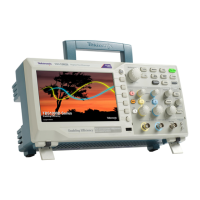
